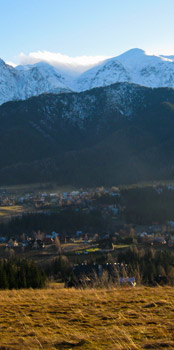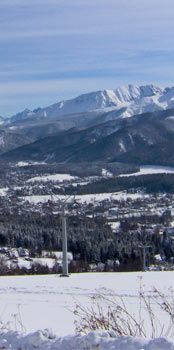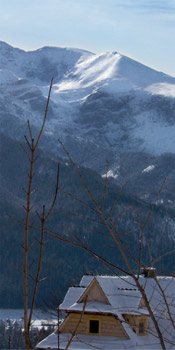- The area Koscielisko
- Zakopane
- Podhale Region
- National Park
- Slovakia
Region
Koscielisko – known in the past as the Glades

Koscielisko is a big village consisting of 21 housing areas (glades). It is called the heart of the Podhale region and is located on the hillsides of the Mt Gubalowka range offering an outstanding view of the high Tatra Mountains.
Nowadays, Koscielisko is one of the main tourist destinations in Poland. The tourist industry has completely overshadowed the formerly popular farming or animal keeping. Highly skilled local professions of carpentry and wooden house building have become most influential. The folk art and crafts are also in full bloom, especially artist-blacksmithing.
The Koscieliska Valley is considered to be one of the most beautiful valleys in the Tatra Mountains. With 35 thousand squared meters it is also one of the biggest and has many side-valleys like the Mietusia Valley, the Tomanowa Valley, and the Pyszna Valley. The last one is unreachable as there is no official trail leading to it nowadays. The highest summit in the Koscieliska Valley is Mount Blyszcz (with the elevation of 2159 meters above sea level). Although it is located far away from it, the Koscieliska Valley offers a view on Mount Bystra (2248 m AMSL) – the highest peak of the Western Tatras. The valley lies amid a long rock canyon. There are three places where its walls come very close to each other forming so called gates (named the Kantaka Gate, the Kraszewskiego Gate, and the Raptawicka Gate). The valley is divided into three parts: upper, middle, and lower. As each part was formed by different natural phenomena the ones who are especially interested in rocks and mountain forming can learn a valuable lesson as they walk along the valley. Nature has formed the valley with abundance of fascinating shape rocks, smooth walls, and caves like the Mrozna Cave, the Smocza Jama Cave, the Mylna Cave, and Raptawicka Cave (some of which are the biggest in the Tatras).
Everyone willing to walk along the valley must get to Kiry. It is one of the most popular bus-stops and there are plenty of buses or mini-buses going to this destination from Zakopane. In Kiry you can also find a car parking where you can leave your car at a small fee. No cars are allowed into the valley. Those who don’t like to walk can take a ride along the valley in horse-drawn carriages (in summer) or sleighs (in winter). The high season draws numbers of tourists there. The valley is located in the Tatra National Park. You are allowed into the park at a small fee.
Region
Zakopane

Zakopane is the main town of the area and is seat of the region authorities. The area of Zakopane and the region offers outstanding natural conditions. It is full of easily accessible hills and high mountains built of different types of rocks. Zakopane is a perfect place for those who would like to feel close to this abundant nature as it stretches from the Western Tatras up to the Czorsztyn Lake and the famous Dunajec River.
Zakopane is known as the Winter Capital of Poland. The Tatra Mountains provide perfect conditions for sports and activities throughout all year. There are plenty of places to ski, ride bikes or snow quads as well as walk or hike along the trails of every difficulty.
Some of the relatively short walking trails around Zakopane are famous all over Poland. Especially the ones just at the entrance to the National Park which form a natural northern border of the Tatras. The names like the Bialego Valley or the Strazyska Valley sound familiar to almost everyone who has ever visited the area. Right next to these two, there is the Ku Dziurze Valley leading to a big mountain cave or the less popular but as beautiful – the Lejowa Valley, the Olczyska Valley, or the Filipka Valley in the High Tatras. Most valleys formed along mountain torrents which are still present these days. Rapid waters add to the beauty of the valleys as much as their noise.
Mountain lakes provide the most stunning views in the Tatras. A half-a-day walk will take you to higher parts of the valleys where some of the most beautiful lakes can be found. Try a breathtaking walk to the most popular Morskie Oko Lake (34,54ha big) or Wielki Staw Polski (34,14ha big and 79,3m deep). Most of the lakes situated one next to the other can be found in the Suchej Wody Gąsienicowej Valley.
Region
Podhale Region

The region is surrounded by mountains: the Gorce Mountains in the North, the Tatra Mountains in the South, the Pieniny Mountains in the East, and the Polica and Mt Babia Gora range in the West. The region is one of the most popular destinations for tourists from all over Poland and all over the world both in summer and winter.
The Tatra District
Location: The district is located in a mountaineous area of the Carpathians (which includes the Tatras and stretches from Czech Republic through Poland all the way South to Romania and a bit of Serbia). The district borders with Slovakia.
- Main towns: Zakopane (population of 29800)
- Main villages: Bialy Dunajec, Bukowina Tatrzanska, Koscielisko, Poronin
- Area: 471,6 km2
Region
The Tatra National Park

The Tatra National Park created in 1954, is one of the 23 national parks in Poland. The authorities had decided to separate the whole area of the mountains and a part of the region below. The Tatras are the only high mountains in Poland. The highest peak is Mt Gerlach (2655m AMSL) which lies on the Slovakian side of the Tatras. The highest peak in Poland is Mt Rysy (2499m AMSL). The whole area of the Tatra Mountains is around 750 square kilometers of which only 150 thousand square meters is located on the Polish territory. The rest of it belongs to Slovakia. It is here where many rivers have their source. All rivers originating in the Polish Tatras flow into the Baltic Sea. Most rivers originating in the Slovakian part of the Tatras flow into the Black Sea (the Orawa River, the Wag River) or the Baltic Sea (the Poprad River) as well.
The process of mountain formation is resembled in the division of the Tatras into three parts: the Western Tatras, the High Tatras and the Bielskie Tatras (located entirely in Slovakia). As the Tatras originated from the Alpine orogeny they are home to such types of rocks as: granite, dolomite, or limestone. The Western and Bielskie Tatras are especially interesting to cavers as there is an abundance of caves and little natural rock wonders to study.
The climate of the Tatras and the types of plants differ from layer to layer as we move towards the highest peaks. The lowest part of the mountains is covered with forests of spruces dominating firs, beeches, and sycamore maples. The middle part of the mountains hosts only forests of spruces. The sub-alpine layer is dominated mostly by bushes and mountain pines. The alpine layer contains mostly alpine meadows and alpine plants (gentiana, dianthus, alpine anemone, or edelweiss). The highest, alpine tundra layer surprisingly hosts numerous plants growing in tufts only in between rocks. Most popular animals in the Tatras include: chamois and marmot - both of which have evolved to become endemic to this region of the world), bear (the unwritten king of the Tatras), deer, roe deer, weasel, or lynx. Among birds: golden eagle, wallcreeper (easily recognizable by the red feather on the sides).
Region
Slovakia

A country that directly borders the region of Zakopane. A place perfect for all skiing fans and those in love with mountainous, alpine views. It is here where you can find over 900 skiing slopes and 30 cable cars able to transport over 415 thousand people per hour. Slovakia sports 20 big, 40 middle-sized and 250 small skiing centers. New slopes are being prepared every single year and with the constantly widening spectrum of services make it easy to satisfy even the most demanding winter-time visitors.
Snow cannons are present on over 90 skiing centers, which makes it possible to enjoy over 170 km of skiing slopes. The skiing season lasts from 130 to 160 days a year. Most popular skiing destinations are located in the Western, High, and Lower Tatras, or the Mala and Wielka Fatra. Thermal-water swimming pools are very often located right next to skiing slopes, which makes a visit here even more enjoyable. Most popular thermal-water swimming centers include: the Tatralandia (next to Liptowski Mikulasz), Beszeniowa, Oravice, Rajeckie Teplice, Vyšne Ružbachy or the Aquacity Poprad. All skiers can enjoy a bath in natural thermal waters of 32-38° C.
Combined with a wide offer of spa treatments make it a perfect place to be for any skiing fan. Outdoor and indoor swimming pools which offer a spectacular views of the snow covered peaks will knock you off your feet.
